Why Is My Dog Holding His Tail Funny
The lobby of my dog's groomer is covered in cutesy dog-related posters and signs. The wall you look at when you come in is like a real-life Pinterest board. The signs are all adorable, of course, but one has always stuck with me more than the rest. It says "dogs smile with their tails."
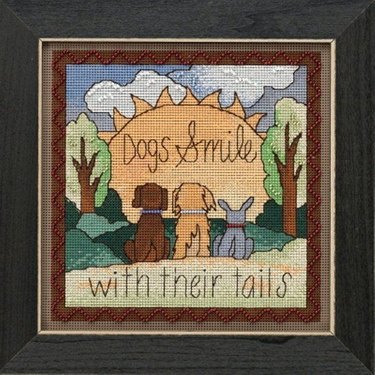
It's one of those little sayings that just feels true, you know? Any pup parent can read that and instantly picture the happy, excited swish of their doggo's tail when he's just overjoyed with life. But does a wagging tail always mean that a dog is happy? Or can it mean other things too?
Here's everything you need to know about the many meanings behind your dog's different kinds of tail wags.
Why do dogs wag their tails?
Like many of the adorable-but-perplexing things that dogs do, tail wagging exists as a form of canine communication. Dogs use their tails to send signals to other dogs (and humans). Factors like the tail's position and the speed of the wagging combine to send clear messages about how a dog is feeling.

Image Credit: Upyanose/iStock/GettyImages
According to Lynn Buzhardt, DVM, a pet behavior expert for VCA Hospitals, it all comes down to evolution.
"Tail wagging works well for dogs," she explains. "Since canine vision is attuned more to movement than to colors or details, dogs readily discern different tail wags. Evolution has also helped by producing tails that are more visible. Some tails have color variations such as dark or light tips, some are lighter on the underside, and some are really bushy. All of these traits accentuate the tail wag and enhance communication."
What does it mean if a dog's tail is wagging?
While it's true that a vigorously swishing tail can be a sign that dog is happy and ready for pets and loving, you need to look closely at the details—like the tail position and the speed of the swish—to interpret a wagging tail's true meaning.
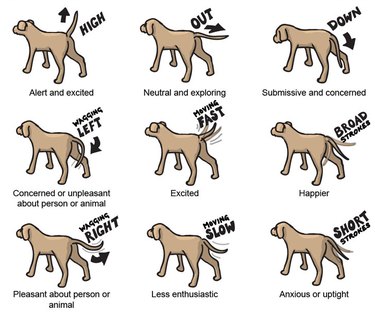
Tail direction:
Here's a fun fact: The direction your dog is wagging their tail is a tell-tale tell (try saying that ten times fast). According to Live Science, a 2007 study found that when dogs wag their tails to the right, it's a sign that they've feeling positive emotions, while wagging to the left indicates negative emotions.
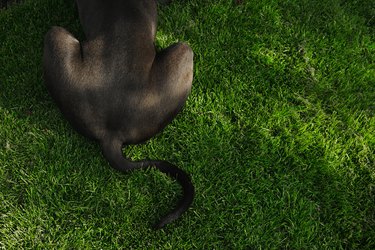
Image Credit: ChristopherBernard/iStock/GettyImages
Researchers believe that the reason for this can be traced back to brain hemispheres, which control the opposite side of the body (the left hemisphere controls the right side of the body and vice versa). In animals, research has found that the left hemisphere of the brain is associated with positive feelings, while the right hemisphere is tied to negative feelings. What's more, a 2013 study found that dogs intuitively understand this cue too and become calm and relaxed if another dog wags their tail to the right and stressed out if another dog's tail is wagging leftward.
Tail speed:

Image Credit: Back in the Pack dog portraits/Moment/GettyImages
The other major factor to look for when interpreting moving tail-based communication is the speed of the wagging tail. As Buzhardt notes, at least four emotions can be indicated by the speed and intensity of a tail wag:
- Excitement: As a rule, the faster a tail wags, the more excited a puppy is. Fun fact: the extremely rapid thumping of unbridled puppy excitement is known as flagging.
- Insecurity: When dogs are feeling uncertain, nervous, or insecure, (particularly while around another dog or a new person), they may wag their tails very slightly.
- Friendliness: Dogs who want to signal that they're friendly will wag their tail with abandon and will often get their hips into it, too.
- Aggression: If you see a dog wagging his tail really quickly while the tail is vertical, beware. This is a sure sign that the dog is feeling threatened and is prepared to respond with aggression.
What can tail position tell you about a dog's mood?
Even if a dog's tail is motionless, the position of the tail can tell you a lot about their mood. Here are just a few of the different signals a dog can give you by the way they hold their tail:
Happy:

Image Credit: bschuitdesign/iStock/GettyImages
If a dog's tail is wagging vigorously (you know, that "I'm gonna knock everything off the coffee table" swish), it is probably a good indication of happiness or, at very least, positive excitement of some kind.
Relaxed:

Image Credit: Compassionate Eye Foundation/DigitalVision/GettyImages
If a dog is relaxed and calm, their tail will be in its natural position, which can vary by breed. For most dogs, this natural, relaxed position involves the tail hanging calmly down by its hocks or heels. For some breeds though—like pugs with their curled, upward-facing tails and greyhounds with their tails that naturally rest between their legs, for example—this could be very different.
Nervous or scared:
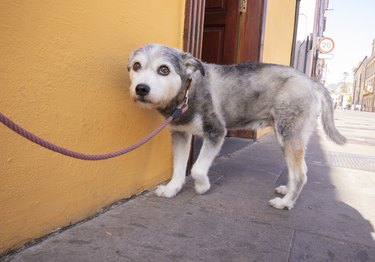
Image Credit: imv/iStock/GettyImages
Dogs who are feeling nervous will hold typically lower their tails below their natural position. If nervousness gives way to outright fear, the dog will likely tuck its tail under its body—this lowering of the tail sends a signal to other dogs that the pooch in question is being submissive and isn't posing a threat.
Agressive or mad:

Image Credit: alexei_tm/iStock/GettyImages
Since lowering the tail is a way for dogs to show that they're feeling submissive and skittish, it shouldn't come as much of a surprise that the opposite feeling is expressed with the opposite tail position. When a dog holds their tail high and straight up, it's often a sign of aggression.
Curious:
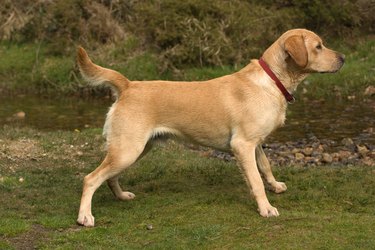
Image Credit: Moorefam/iStock/GettyImages
If your dog is just curious about something—a strange sound, a new smell, a quick movement that could be a squirrel—they might hold their tail straight out, almost as if focusing the tail can focus their attention.
Conclusion
It's easy to understand why so many people assume that a wagging tail is a sign of a friendly, happy pup, but, as you can see, that's not always the case. Next time you see a dog wagging their tail, take the time to full interpret what they're trying to tell you with the details of that wag (and the rest of their body) before you approach for love and pets.
desrosiersmartyart.blogspot.com
Source: https://www.cuteness.com/13727272/does-tail-wagging-always-mean-a-dog-is-happy
0 Response to "Why Is My Dog Holding His Tail Funny"
Post a Comment